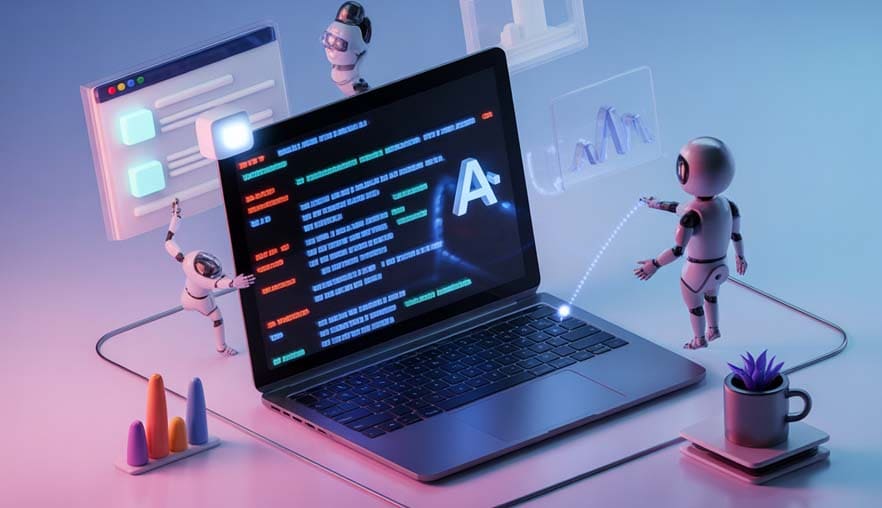Artificial intelligence is no longer a futuristic concept but an integral part of web development, reshaping how websites are designed, built, and optimized. From streamlining tedious tasks to creating hyper-personalized user experiences, AI is fundamentally changing the digital landscape for businesses and developers alike. This guide explores how AI-powered web development works, its transformative benefits, the top tools shaping the field, and a detailed look at how your agency can leverage this trend to build smarter, more successful websites.
AI-powered web development refers to the integration of machine learning algorithms, natural language processing, and other AI technologies into the website creation and management process. Instead of purely manual coding and design, developers can now use AI to:
- Automate repetitive tasks, from code generation to testing and deployment.
- Analyze user behavior in real-time to personalize content and layout dynamically.
- Optimize performance by predicting traffic patterns and adjusting server loads.
- Enhance security through predictive threat detection.
This evolution means websites are no longer static digital brochures but intelligent, dynamic, and responsive platforms that learn and adapt to user needs.
The transformative benefits of AI in web development
For web development agencies, embracing AI offers a powerful competitive advantage. For clients, it leads to a more robust, efficient, and profitable online presence.
Accelerated development and reduced costs
AI automates repetitive and time-consuming tasks like boilerplate code generation, testing, and debugging. This significantly reduces development time and associated labor costs, allowing your team to focus on strategic, creative problem-solving.
- Rapid Prototyping: Tools like Relume.io can generate sitemaps and wireframes in seconds, dramatically speeding up the initial planning and design phase.
- Faster time-to-market: By streamlining workflows, AI helps bring websites and new features to market much faster than traditional methods.
Enhanced user experience (UX) and personalization
AI enables a level of personalization that is impossible to achieve manually, leading to more engaging and satisfying user experiences.
- Hyper-personalized content: AI analyzes user data—such as browsing history, location, and preferences—to dynamically display tailored headlines, product recommendations, and content.
- Intuitive navigation: Machine learning can analyze user behavior to optimize website navigation and layouts in real-time, reducing friction and bounce rates.
Proactive security and maintenance
AI-powered systems provide an advanced layer of security by monitoring and predicting potential threats in real-time.
- Threat detection: AI algorithms can analyze traffic patterns to detect and mitigate cybersecurity threats like DDoS attacks, fraud, and unauthorized access.
- Predictive maintenance: AI systems can analyze website data to anticipate potential performance issues before they occur, allowing for proactive optimization.
Streamlined content creation and SEO
AI has made content creation more efficient and SEO more precise, helping clients stand out in a crowded market.
- Automated content generation: AI writers can generate product descriptions, marketing copy, and blog posts, freeing up content teams to focus on strategy.
- Smarter SEO: AI-powered SEO tools can analyze keywords, readability, and user intent to suggest optimizations that help websites rank higher in search results.
| Category | Tool Example | Use Case |
|---|---|---|
| Code Assistants | GitHub Copilot, Tabnine | Auto-completes code, suggests code snippets, and helps with debugging, allowing developers to code faster and with fewer errors. |
| Design & Prototyping | Uizard, Midjourney | Turns sketches and text prompts into wireframes and high-fidelity mockups, significantly accelerating the design process. |
| Testing & QA | Testim.io, Applitools | Automates regression and end-to-end testing, and uses visual AI to detect UI bugs and inconsistencies across different browsers and devices. |
| Personalization | Dynamic Yield, Adobe Target | Delivers real-time personalized content, product recommendations, and CTAs based on user behavior. |
| No-Code / Low-Code | Wix ADI, Bubble | Allows non-developers and developers to build websites and web apps rapidly using AI-powered automation and drag-and-drop interfaces. |
| Content & SEO | Jasper AI, SurferSEO | Assists with generating high-quality copy, blog posts, and optimizing content for better search engine rankings. |
| Chatbots & Voice | Dialogflow, Rasa | Frameworks for building conversational AI assistants that provide 24/7 customer support and enhance user engagement. |
The human-AI collaboration: a winning strategy
While AI automates many tasks, it doesn’t replace the need for human developers. Instead, it transforms their role, allowing them to focus on high-value, creative, and strategic work.
- Creative Oversight: Human designers are still essential for brand storytelling, creative direction, and ensuring the final product connects with users on an emotional level.
- Strategic Problem-Solving: AI excels at analyzing data and executing tasks, but it’s human expertise that guides the strategy and identifies the right problems to solve.
- Ethical Oversight: Developers must ensure that AI models are trained on unbiased data and that privacy is protected, addressing the ethical concerns that AI can raise.
A blueprint for AI-powered web development
To successfully integrate AI into your web development services, consider a phased and strategic approach.
- Start with high-impact opportunities. Focus on specific, measurable challenges like reducing customer service response times with a chatbot or automating content generation for your client’s blog.
- Select the right AI tools. Evaluate your needs and choose tools that integrate seamlessly with your existing technology stack and align with your project goals.
- Implement iteratively. Deploy AI features in small, manageable sprints. Treat it as a continuous learning process, gathering feedback and refining based on real-world performance data.
- Invest in your team. Provide training and certifications to help your developers effectively use AI tools. Encourage collaboration between your AI experts, designers, and business strategists.
- Maintain a strong ethical posture. Prioritize data privacy, transparency, and fairness in your AI implementations. Be upfront with your clients and their users about how AI is being used.
Looking ahead: the future of AI in web development
The rise of AI in web development is not a passing trend but a foundational shift. As AI continues to evolve, we can expect:
- Agentic AI Systems: Autonomous AI agents capable of independent decision-making, planning, and task execution, potentially self-optimizing a website’s performance in real-time.
- Hyper-Personalization: Websites will become even more predictive, anticipating user needs with pinpoint accuracy based on their real-time behavior, context, and even emotional state.
- Multi-Modal AI: The integration of AI that can process information from multiple sources—text, image, and voice—at once, enabling more immersive and intuitive user experiences.
For a web development agency, the key to thriving in this new era is to embrace AI not as a replacement for human talent but as a powerful partner. By combining AI’s efficiency with human creativity, you can build smarter, more innovative, and more successful websites that deliver exceptional results for your clients.


